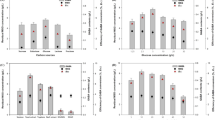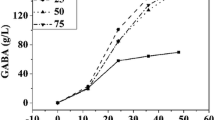Abstract
The proliferation mechanism of Lactobacillus plantarum RB1 promoted by stachyose was investigated in this work. The hydrolysis of stachyose, the glycometabolism, and the cytoactivity of L. plantarum RB1 were detected after proliferation. The specific activity of α-galactosidase of L. plantarum RB1 in the stachyose group was significantly higher than the control group (without stachyose), which indicated that the stachyose induced L. plantarum RB1 and produced more α-galactosidase to hydrolyze stachyose. The glycometabolism which includes glycolysis and tricarboxylic acid (TCA) cycle was significantly enhanced in the stachyose group compared with the control group. For the glycolysis, the reducing sugar content in the fermentation broth was significantly lower, while the lactic acid content and the specific activity of lactic dehydrogenase (LDH) as the key enzyme in glycolysis were higher than in the control group. For the TCA cycle, the specific activity of pyruvate dehydrogenase (PDH) as a gatekeeping enzyme leads glycolysis to TCA cycle energy-generating pathways was significantly enhanced compared with the control group. Moreover, the cell metabolic activity of L. plantarum RB1 in stachyose was significantly higher than the control group. These results indicated that the stachyose highly promotes proliferation of lactic acid bacteria (LAB) by inducing LAB to produce more α-galactosidase to hydrolyze stachyose, increasing glycometabolism and cytoactivity of LAB, which revealed the mechanisms how the stachyose promotes the proliferation of LAB.




Similar content being viewed by others
References
Alkonyi I, Bolygó E, Gyócsi L, Szabó D (1976) Studies on the formation of acetoin from acetaldehyde by the pyruvate dehydrogenase complex and its regulation. Eur J Biochem 66(3):551–557
Almeida A, Bolaños JP, Moncada S (2010) E3 ubiquitin ligase APC/C-Cdh1 accounts for the Warburg effect by linking glycolysis to cell proliferation. Proc Natl Acad Sci USA 107(2):738–741
Barker SB, Summerson WH (1941) The colorimetric determination of lactic acid in biological material. J Biol Chem 138(2):535–554
Chan FKM, Moriwaki K, Rosa MJD (2013) Detection of necrosis by release of lactate dehydrogenase activity. Methods Mol Biol 979:65–70
Dierking EC, Bilyeu KD (2009) Raffinose and stachyose metabolism are not required for efficient soybean seed germination. J Plant Physiol 166(12):1329–1335
Fredslund F, Hachem MA, Larsen RJ, Sørensen PG, Coutinho PM, Lo Leggio L, Svensson B (2011) Crystal structure of α-galactosidase from Lactobacillus acidophilus NCFM: insight into tetramer formation and substrate binding. J Mol Biol 412(3):466–480
Goldman RD, Kaplan NO, Hall TC (1964) Lactic dehydrogenase in human neoplastic tissues. Cancer Res 24(24):389–399
Grmanová M, Rada V, Sirotek K, Vlková E (2010) Naturally occurring prebiotic oligosaccharides in poultry feed mixtures. Folia Microbiol 55(4):326–328
Haslam G, Richter M, Wyatt D, Ye QZ, Kitos P (2005) Estimating the number of viable animal cells in multiwell culture-a tetrazolium-based assay. Anal Biochem 336(2):187–195
Jeffrey GA, Huang DB (1991) Hydrogen bonding in the crystal structure of the tetrasaccharide stachyose hydrate: a 1:1 complex of two conformers. Carbohydr Res 210(210):89–104
Kaplon J, Zheng L, Meissl K, Chaneton B (2013) A key role for mitochondrial gatekeeper pyruvate dehydrogenase in oncogene-induced senescence. Nature 498(7452):109–112
Li X, Qin C, Burghardt R, Safe S (2004) Hormonal regulation of lactate dehydrogenase-A through activation of protein kinase C pathways in MCF-7 breast cancer cells. Biochem Biophs Res Commun 320(3):625–634
Manning TS, Gibson GR Prebiotics (2004) Best Pract Res Clin Gastroenterol 18(2):287–298
Miller GL (1959) Use of dinitrosalicylic acid reagent for determination of reducing sugar. Anal Chem 31(3):426–428
Mital BK, Shallenberger RS, Steinkraus KH (1973) α-Galactosidase Activity of Lactobacilli. Appl Microbiol 26(5):783–788
Osthus RC, Shim H, Kim S, Li Q, Reddy R, Mukherjee M, Xu Y, Wonsey D, Lee LA, Dang CV (2000) Deregulation of glucose transporter 1 and glycolytic gene expression by c-Myc. J Biol Chem 275(275):21797–21800
Patel MS, Roche TE (1990) Molecular biology and biochemistry of pyruvate dehydrogenase complexes. Faseb J 4(14):3224–3233.
Porter JE, Herrmann KM, Ladisch MR (1990) Integral kinetics of alpha-galactosidase purified from Glycine max for simultaneous hydrolysis of stachyose and raffinose. Biotechnol Bioeng 35(1):15–22
Ravera S, Bartolucci M, Calzia D, Aluigi MG, Ramoino P, Morelli A, Panfoli I (2013) Tricarboxylic acid cycle-sustained oxidative phosphorylation in isolated myelin vesicles. Biochimie 95(11):1991–1998
Sakamoto M, Komagata K (1996) Aerobic growth of and activities of NADH oxidase and NADH peroxidase in lactic acid bacteria. J Ferment Bioeng 82(3):210–216
Shabalin KA, Kulminskaya AA, Savel’Ev AN, Shishlyannikov SM, Neustroev KN (2002) Enzymatic properties of α-galactosidase from Trichoderma reesei in the hydrolysis of galactooligosaccharides. Enzyme Microb Tech 30(2):231–239
Shivam K, Mishra SK (2010) Purification and characterization of a thermostable α-galactosidase with transglycosylation activity from Aspergillus parasiticus MTCC-2796. Process Biochem 45(7):1088–1093
Thom SM, Horobin RW, Seidler E, Barer MR (1993) Factors affecting the selection and use of tetrazolium salts as cytochemical indicators of microbial viability and activity. J Appl Bacteriol 74(74):433–443
Wang H, Cheng H, Wang F (2010) An improved 3-(4,5-dimethylthiazol-2-yl)-2,5-diphenyl tetrazolium bromide (MTT) reduction assay for evaluating the viability of Escherichia coli cells. J Microbiol Methods 82(3):330–333
Zaunmüller T, Eichert M, Richter H, Unden G (2006) Variations in the energy metabolism of biotechnologically relevant heterofermentative lactic acid bacteria during growth on sugars and organic acids. Appl Microbiol Biotechnol 72(3):421–429
Zhou Y, Xu DS, Liu L, Qiu FR, Chen JL, Xu GL (2015) A LC-MS/MS method for the determination of stachyose in rat plasma and its application to a pharmacokinetic study. J Pharm Biomed 123:24–30
ZięTara MS, Skorkowski EF (1995) Thermostability of lactate dehydrogenase LDH-A 4, isoenzyme: effect of heat shock protein DnaK on the enzyme activity. Int J Biochem Cell B 27(11):1169–1174
Acknowledgements
This work was financially supported by the Projects of the National Natural Science Fund of P.R. China (41406165, 41641052) and K. C. Wong Magna Fund in Ningbo University.
Author information
Authors and Affiliations
Corresponding author
Rights and permissions
About this article
Cite this article
Pan, Q., Zeng, X., Pan, D. et al. The Proliferation Mechanism of Lactobacillus plantarum RB1 Stimulated by Stachyose. Curr Microbiol 74, 732–738 (2017). https://doi.org/10.1007/s00284-017-1229-7
Received:
Accepted:
Published:
Issue Date:
DOI: https://doi.org/10.1007/s00284-017-1229-7




